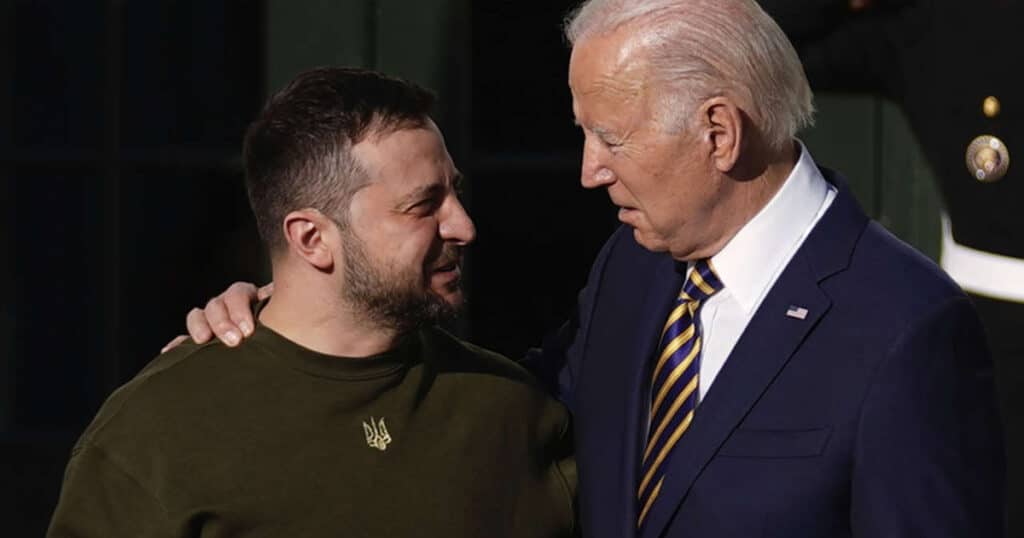
Zelenskyy Demands Using US Weapons on Targets in Russia
The war in Ukraine continues to rage on 2 1/2 years after Russian forces breached their neighbor’s borders. The protraction of the conflict has only made a Russian victory—through a favorable settlement or Ukrainian surrender—more likely, though it will come at a much higher cost to the Russians than originally anticipated by both Moscow and Washington. The simple truth is that Russia has more men, more resources, and is not reliant on the goodwill of Western benefactors.
While continued aid from the United States keeps the Ukrainian war effort afloat, that aid has come with certain strings attached. U.S. weapons given to Ukraine, for example, cannot be used to strike targets within Russian territory.
Whether Ukraine has upheld its end of the bargain is unlikely. Ukraine has privately received permission from President Joe Biden to use U.S. weapons in strikes on Russia in the past. Now, Ukrainian President Volodymyr Zelenskyy is looking to negotiate, not with Russia but with the United States and other benefactors, to permanently loosen those restraints.
While Zelenskyy has made a habit of making this request, he did so again fervently on Monday after Russia launched one of its largest drone and missile strikes of the campaign so far.
In a video statement posted to X on Monday, Zelenskyy said the Russian strike “involv[ed] over a hundred missiles of various types and around a hundred ‘Shaheds’ [attack drones].”
Targets included energy infrastructure installations, such as the hydroelectric plant of the Dnieper River dam at Vyshhorod, resulting in some power outages.
“We must finally unite in our efforts to shoot down Russian missiles and drones,” Zelenskyy continued. “Across Ukraine, we could do much more to protect lives if the aviation of our European neighbors operated in concert with our F-16s and air defense systems. If such unity has proven effective in the Middle East, it must work in Europe, too. Life holds the same value everywhere.”
“Every leader, every one of our partners, knows the decisive actions required to end this war justly. Ukraine cannot be constrained in its long-range capabilities when the terrorists face no such limitations,” Zelenskyy added. “Our defenders cannot be restricted in their weapons when Russia deploys its entire arsenal, including ‘Shaheds’ and ballistic missiles from North Korea. America, Britain, France, and our other partners have the power to help us stop this terror. The time for decisive action is now.”
Some in Washington are not pleased with Zelenskyy’s repeated asks, nor are they pleased with the current administration’s unwillingness to tell Zelenskyy “no” publicly. “For more than two years, the U.S. and NATO partners have done nothing but concede to Ukraine’s demands for cash handouts and increasingly more sophisticated weapons,” Sen. Mike Lee, R-Utah, told The Daily Signal. “This pattern of appeasement has shown Zelenskyy that ‘no’ is never a final answer and that nothing is off the table. That’s exactly why he is now comfortable pressuring the U.S. to lift restrictions on using long-range weapons to strike Russian territory, and he has every reason to believe the Biden-Harris administration will eventually give in.”
“Zelenskyy’s newest demands are consistent with his asks for the past two years and show clearly that he is comfortable fighting this war as long as the U.S. is willing to back him,” Lee added. “The U.S. has endless leverage at its disposal here, but the Biden-Harris administration refuses to use it and instead continues to prop up a military that could not stand on its own.”
The Daily Signal asked George Beebe, the director of grand strategy for the Quincy Institute for Responsible Statecraft, why Ukraine is pushing to use U.S. weapons on Russian targets. “One reason is that Ukraine cannot win a war of attrition, which is what Russia has been waging for the bulk of the war to date. Ukraine lacks sufficient manpower and military industry for this to be a viable path toward Ukrainian victory, and the West cannot make up for Ukraine’s deficits relative to Russia,” Beebe said. “So Ukraine has to turn this into a shorter war of maneuver that capitalizes on superior Western technology and advanced battlefield intelligence. Kyiv hopes that a sustained campaign of deep strikes into Russia will help to transform the war to Ukraine’s advantage.”
Beyond Zelenskyy’s Monday statement, the Ukrainians appear to be using their recent sally into the Russian city of Kursk to justify changing the terms of engagement for U.S. weaponry, even though this advance pales in comparison to Russian territorial gains.
“The Kursk incursion has more political than military logic behind it,” Beebe claimed of the Ukrainian offensive. “Ukraine cannot realistically hope to capture and hold strategically significant Russian territory for very long—it lacks the air power, air defense, logistical support, and manpower advantages this would require.”
“[Zelenskyy’s] aim may be temporarily to bolster hopes in Ukraine and the West, buy some time, and show that he has left no stone unturned in seeking victory on the battlefield before some painful compromises become necessary,” Beebe told The Daily Signal.
If the U.S. falls for the maneuver and publicly approves Ukraine’s request, the U.S. could quickly find itself in direct confrontation with Russia. “Ukraine wants to drag the United States directly into the conflict with Russia,” he continued, because “Ukraine cannot defeat Russia one-on-one.”
“Its best hope is to get direct American involvement on the battlefield, and provoking Russian retaliation against NATO bases or facilities may be Kyiv’s best bet for forcing Washington into the battle,” he said.
“For the Zelenskyy administration, the incentives are clear: more,” The American Conservative Executive Director Curt Mills told The Daily Signal of Zelenskyy’s latest attempt to get approval from Washington to strike targets in Russia with U.S. weapons. “The Ukrainian president has put himself in a position where he cannot rest easy as long as Vladimir Putin lives. While that is sympathetic on a human level, it’s not a price that should be paid with global security. Zelenskyy is still partying like it’s 2022 and will never stop roaring for regime change in Russia as long as Washington permits him.”
“The Zelenskyy state will do whatever it takes to survive,” Mills said. “It’s understandable,” Mills added, “but this can go awry.”
Lee believes “the Biden-Harris administration has no strategy and has been playing a dangerous game testing Russian limits.”
“Two years ago, we were talking about giving Ukraine a striking range of 50 miles exclusively within their own territory and now, we’re openly allowing our weapons to be used inside of Russia with incrementally greater range—an astonishing shift that only further demonstrates the ineptitude of the Biden-Harris administration,” Lee added.
While Zelenskyy has long requested more capabilities with U.S. weapons, Beebe said that “Zelenskyy’s demands reflect his judgments about how best to manage popular and elite opinion in Ukraine, his confidence in America’s willingness to sustain large-scale support, and the course of the war on the battlefield.” If the U.S. rebuffs Zelenskyy, his demands may change “as those variables change—and they are all shifting, though gradually for now.”
Just how much Zelenskyy changes, however, remains to be seen. “It’s unclear Zelenskyy will ever be party to an armistice,” Mills told The Daily Signal. “There’s precedent for this. In the Korean War, the U.S. had to keep the fanatic South Korean leader Syngman Rhee out of the room.”
If the war is to end sooner rather than later, the change will likely have to come from Washington in a new administration.
Beebe identified “three possible courses of action” for a Trump or Harris administration to take in 2025.
The first is going all in with Zelenskyy: “The U.S. could escalate the war and risk direct conflict with Russia.”
The second is to maintain the status quo. “[The U.S.] could refuse either to escalate or negotiate, leaving Ukraine in an unsettled conflict that diminishes in intensity over time but renders the nation dysfunctional and incapable of reconstruction,” Beebe claimed.
The final option, however, is making the necessary trade-offs to bring the war to a close. The next administration “could seek a compromise that enshrines Ukraine’s geopolitical neutrality in return for its economic reconstruction and a path toward the European Union,” Beebe said, “an outcome that will only be possible if the United States plays an active role in orchestrating all the complex diplomacy required.”
Mills is a strong proponent for Beebe’s third way: “We needed an armistice yesterday. A President Trump or President Harris should simply put an end to Washington’s latest fiasco.”
“For more than two years, the U.S. has allowed Ukraine to entertain a fantasy of victory without concessions and singularly on Ukraine’s terms. That’s just simply not the reality of war, and until the U.S. awakens Ukraine from its slumber, the conflict will drag on with empty platitudes of ‘progress’ and ‘peace plans,’” Lee told The Daily Signal.
A new administration, Lee suggests, has the opportunity to do just that. “The next administration needs to make it a Day-One priority to establish a strategy for Ukraine, driven only by U.S. interests and with full awareness of the strategic trade-offs involved in supporting Ukraine at the expense of higher priority theaters. Parallel to a coherent strategy, the next administration needs to be immediately candid with Zelenskyy that the days of appeasement are over, that U.S. weapons may not be used inside Russia, and that any future U.S. aid will be contingent upon peace negotiations.”



